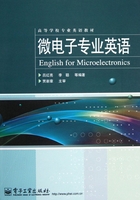
Session 9 Metal-Semiconductor Contacts
Most of the electronic devices that make up an integrated circuit are connected by means of metal-semiconductor contacts. Moreover,all integrated circuits communicate with the rest of an electrical system via metal-semiconductor contacts. As we will see,the properties of these contacts can vary considerably,and it is necessary to consider several factors in order to understand them.
It is well known that the quality of metal semiconductor contacts plays an important role in the performance of various semiconductor devices and integrated circuits. For example,good ohmic contacts are essential for achieving excellent performance of a semiconductor device,while Schottky(i. e.,rectifying)contacts can be used for a wide variety of device applications. In addition to different device and circuit applications,Schottky contacts can also be used as test vehicles for investigating the physical and electrical properties of a semiconductor material and its surfaces.  For example,a Schottky diode can be used to study bulk defects and interface properties of a metal semiconductor system. Therefore,it is essential to obtain a better understanding of the fundamental physical and electrical properties of the metal semiconductor systems so that technologies for preparing good ohmic and Schottky contacts can be developed for a wide variety of device applications.
For example,a Schottky diode can be used to study bulk defects and interface properties of a metal semiconductor system. Therefore,it is essential to obtain a better understanding of the fundamental physical and electrical properties of the metal semiconductor systems so that technologies for preparing good ohmic and Schottky contacts can be developed for a wide variety of device applications. 
Two types of metal semiconductor contacts are commonly used in the fabrication of semiconductor devices and integrated circuits. They are the Schottkyand ohmic contacts . A Schottky barrier contact exhibits an asymmetrical current voltage(I-V)characteristic when the polarity of a bias voltage applied to the metal semiconductor contacts is changed. The ohmic contact,on the other hand,shows a linear I-V characteristic regardless of the polarity of the external bias voltage. A good ohmic contact is referred to the case in which the voltage drop across a metal semiconductor contact is negligible compared to that of the bulk semiconductor material. 